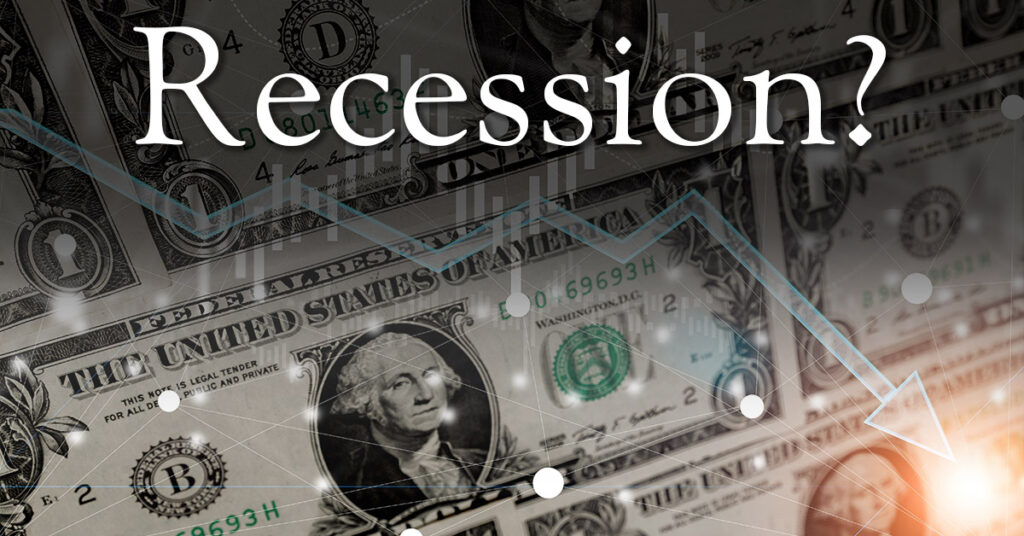2024 Recession?
Economists, investors, and the Federal Reserve have been warning for the past year that a recession may be on the horizon. Although it was thought to be inevitable for 2023, the U.S. economy has so far avoided a downturn. Economic experts, however, still think one is likely on the horizon. But now they’re saying it could be coming next year instead, in 2024.
A recession is a significant, prolonged economic downturn, typically characterized by a decline in economic activity. These include a contraction in gross domestic product, rising unemployment rates, decreased business investment, and reduced consumer spending. Recessions can be caused by different factors, including financial crises, excessive debt, supply shocks, inflation, and external economic events. The Treasury market first began showing signs that the U.S. might be on the brink of a recession almost a year ago, in the last quarter of 2022. This happened when the Fed started its campaign of aggressive interest rate hikes to try and tame inflation. Economists predicted it would begin in 2023. So, where is this long-anticipated recession?
Well, it’s important to remember that there’s a buffer between the Fed’s rate hikes and when they actually start to impact the economy. According to Jerome Powell, Chair of the Federal Reserve, the rate hikes will take “a year and change” to take effect. It’s been over a year since the rate-hiking cycle began, which means they could fully take hold soon.
After the economy proved itself more resilient than expected and pulled through, the case for a 2023 recession has been crumbling. Thus, predictions have been pushed forward in time. But just because we’ve kicked the recession further down the road doesn’t mean it’s not coming. How likely is it that we’ll face an economic downturn in 2024?
How Likely Is a Recession?
78% of surveyed experts* indicated that the chance of an upcoming recession was greater than 50%. 28% said the odds were 70% or higher. This shows probable odds that an economic environment featuring slower business growth, job loss, and a tougher stock market is on the horizon. However, economists were mostly in agreement that the projected recession is at least unlikely to be as severe as the downturn that came with the coronavirus pandemic.
The Federal Reserve’s Beige Book report on September 6th showed that the economy grew modestly in July and August, bolstered by “the last stage of pent-up demand” for leisure activities. Meanwhile, Goldman Sachs economists stated that the odds of a recession in the next 12 months are at 15%, meaning that to them there isn’t a pressing danger of one.
Next, there’s what the yield curve indicates. Proven in the past to be a reliable warning sign of a recession, an “inverted yield curve” shows that long-term interest rates are less than short-term interest rates. Based on data acquired since the 1960s up until today, recessions take an average of 589 days to occur following the 10-year and 3-month yield curve first inverted. It’s tempting to shrug off the yield curve in this cycle, but history has shown us that recessions haven’t been quick to arrive after the yield curve first inverts. So we should still be concerned.
A Recession is Still a Risk
Recessions are an accepted, inevitable part of the business cycle. And, few recessions were as easy to predict as the one that came in the aftermath of the Coronavirus pandemic. Right now, the Federal Reserve is raising interest rates to a level not matched since 2007, and at a pace not seen since the 1980s. The Fed has never been able to raise interest rates this far and fast without causing an economic downturn. In fact, they’ve never been able to cool down excess inflation without prompting one. But, to the surprise of most economists, this downturn still hasn’t yet shown up. Several factors have delayed the onset of a recession this year:
- The Social Security cost-of-living adjustment in January
- The residual resilience of the labor market
- The restarting of China’s economy
- The loosening of financial conditions in stocks and bank liquidity following the March banking crisis
The economy has since slowed after its grand reopening following the pandemic and resulting lockdowns. Banks have tightened, lending standards as a result of the three major bank failures earlier this year. But, consumers have continued spending, and the labor market is still chugging along.
Reach Out to Us
In today’s economic landscape, concerns about a recession remain on the minds of many. And while we can’t predict the future, we can prepare. If you’re worried about all this talk about an economic downturn on the way, don’t worry: We can help. Reach out to us! There are ways for you to safeguard your financial future you might not be aware of. Your financial goals and needs are unique, and so your strategy should be, too. We can meet with you, talk about your situation, and make recommendations tailored to your specific needs. You should be able to stay protected, no matter what happens in the economy in the years to come.
We can help you understand your options and implement strategies to hopefully minimize losses. American Principal is here to help you get educated, in order to make the right decisions and protect your future. Contact us today to attend an educational dinner seminar, or book a no-obligation, one-on-one meeting with us. We may be able to help you create a financial strategy that offers you confidence, even in uncertain times.
*Sources: MarketWatch, Bankrate, CNN Business.

